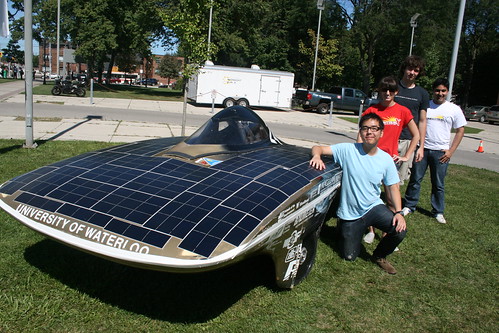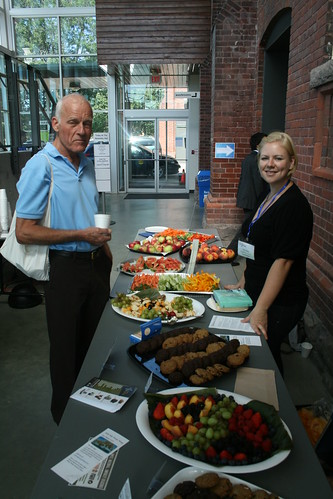CHART OF THE MONTH - SEPTEMBER 2011
Price Development of Solar PV, Feed-in Tariffs and Elections
In our last Chart of the Month we claimed that the costs of renewable energy had one direction only: “down, down, down”. This month we’re looking at the consumer end of things. Our chart shows the development of prices for fully installed solar PV systems in Germany and Canada over the last few years. There are two graphs for each country: smaller residential systems (<10kW) aka microFITs and larger systems (> 10kW).

Here are some observations and conclusions:
The general price trend: There is only one trend indeed – down. Germany has been leading that trend which is most likely induced by an incremental and continued reduction of feed-in tariffs. We strongly believe that this trend will continue in the foreseeable future as the technology will advance and the overall efficiency of the technology and the entire industry will increase.
The market and supply effect on price: Solar of course isn’t exempt from global market conditions. In 2007, for example, prices went up due to high global demand for silicon wafers and other components caused by a booming (overheating) world economy.
The prices solar PV owners pay: In 2009 consumers had to pay a premium for smaller systems in Canada. That year the Green Energy and Green Economy Act was launched in Ontario introducing a microFIT rate of 80.2 cents/kWh for small and mostly residential systems up to 10 kW. The providers of systems in the early phases were able to bank in on those tariffs. As more and more competitors enter the field the prices per installed kilowatt capacity are prone to drop significantly in the next few years. Also most residential customers are better informed now and question prices and fees for hardware, service and consulting.
The prices we pay for electricity: Albeit being higher compared with similar feed-in tariff programs around the world for this small system segment, high feed-in tariffs in Ontario were and still are instrumental in attracting Ontarians to a new industry that was previously non–existent. The higher tariffs are, nevertheless, still justifiable due to the local content rules and a lower sun radiation than in most other jurisdictions with similar feed-in tariffs (e.g. Spain or Italy). Currently, the amount of electrical power fed into the grid from microFIT systems has no significant contribution to rising electricity prices for consumers in Ontario. This is a myth and scenario eagerly painted by those presently cashing in on “old energy”.
Crystal Ball I – the future of solar PV in Germany: Prices in Germany have been in free fall over the last years. The phase-out of nuclear power in Germany can have opposite and thus maybe neutralizing effects on prices: Up – as demand for panels, inverters and qualified installers will increase. Down – as the German market will become once again very attractive and increasing efficiencies may be unleashed with increasing government support for solar R&D.
Crystal Ball II – the future of solar PV in Ontario: With renewable energy being a hot topic in the upcoming provincial election in Ontario, one outcome may be easily predicted. The feed-in tariffs for solar PV projects will come down. The question that remains is by how much? The chart presented here proposes that a 10-13% decrease is possible considering that the local market still needs some support. Should the Conservatives axe the feed-in tariff program entirely or reduce the rates beyond that they will significantly damage if not nip this evolving industry in the bud.
Our Conclusion: It requires a healthy combination of market forces at work and a strong political will translated into transparent and reliable policies to keep the prices for all at balance, the consumers happy and the industry growing.

Here are some observations and conclusions:
The general price trend: There is only one trend indeed – down. Germany has been leading that trend which is most likely induced by an incremental and continued reduction of feed-in tariffs. We strongly believe that this trend will continue in the foreseeable future as the technology will advance and the overall efficiency of the technology and the entire industry will increase.
The market and supply effect on price: Solar of course isn’t exempt from global market conditions. In 2007, for example, prices went up due to high global demand for silicon wafers and other components caused by a booming (overheating) world economy.
The prices solar PV owners pay: In 2009 consumers had to pay a premium for smaller systems in Canada. That year the Green Energy and Green Economy Act was launched in Ontario introducing a microFIT rate of 80.2 cents/kWh for small and mostly residential systems up to 10 kW. The providers of systems in the early phases were able to bank in on those tariffs. As more and more competitors enter the field the prices per installed kilowatt capacity are prone to drop significantly in the next few years. Also most residential customers are better informed now and question prices and fees for hardware, service and consulting.
Crystal Ball I – the future of solar PV in Germany: Prices in Germany have been in free fall over the last years. The phase-out of nuclear power in Germany can have opposite and thus maybe neutralizing effects on prices: Up – as demand for panels, inverters and qualified installers will increase. Down – as the German market will become once again very attractive and increasing efficiencies may be unleashed with increasing government support for solar R&D.
Crystal Ball II – the future of solar PV in Ontario: With renewable energy being a hot topic in the upcoming provincial election in Ontario, one outcome may be easily predicted. The feed-in tariffs for solar PV projects will come down. The question that remains is by how much? The chart presented here proposes that a 10-13% decrease is possible considering that the local market still needs some support. Should the Conservatives axe the feed-in tariff program entirely or reduce the rates beyond that they will significantly damage if not nip this evolving industry in the bud.
Our Conclusion: It requires a healthy combination of market forces at work and a strong political will translated into transparent and reliable policies to keep the prices for all at balance, the consumers happy and the industry growing.
+v2.jpg)



